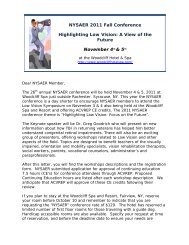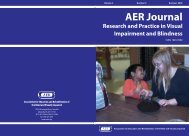Association for Education and Rehabilitation of the Blind - AER Online
Association for Education and Rehabilitation of the Blind - AER Online
Association for Education and Rehabilitation of the Blind - AER Online
Create successful ePaper yourself
Turn your PDF publications into a flip-book with our unique Google optimized e-Paper software.
Vision, Posture, <strong>and</strong> Ageing<br />
head in space <strong>and</strong> provides a reference frame <strong>for</strong> <strong>the</strong><br />
organization <strong>of</strong> <strong>the</strong> rest <strong>of</strong> <strong>the</strong> body. It is, however,<br />
generally agreed that a number <strong>of</strong> interrelated factors<br />
control postural stability, <strong>the</strong> main inputs coming from<br />
<strong>the</strong> somatosensory (chiefly proprioceptive <strong>and</strong><br />
tactile), vestibular, <strong>and</strong> visual systems (Black &<br />
Wood, 2005; Horak, 2006; Roberts, 1995).<br />
Proprioception<br />
Proprioceptors are specialized receptors in skeletal<br />
muscles, tendons, joints, ligaments, <strong>and</strong> connective<br />
tissues that monitor stretch. With our eyes closed<br />
or in a dark room, we are still aware <strong>of</strong> <strong>the</strong> position <strong>of</strong><br />
our limbs <strong>and</strong> <strong>the</strong>ir orientation with respect to each<br />
o<strong>the</strong>r, at least in a general sense. This is our sense <strong>of</strong><br />
position (Schmidt, 1986). If we have not moved <strong>for</strong> a<br />
long time or when we wake up, our position sense is<br />
generally well preserved. If we change <strong>the</strong> position <strong>of</strong><br />
a joint <strong>and</strong> <strong>the</strong>re<strong>for</strong>e <strong>the</strong> relationship <strong>of</strong> body parts to<br />
each o<strong>the</strong>r without visual control, we perceive <strong>the</strong><br />
direction <strong>and</strong> <strong>the</strong> velocity, <strong>and</strong> this is our sense <strong>of</strong><br />
movement (Schmidt, 1986). The ability to estimate <strong>the</strong><br />
amount <strong>of</strong> muscular <strong>for</strong>ce necessary to move or<br />
maintain position is called our sense <strong>of</strong> <strong>for</strong>ce (Schmidt,<br />
1986). Toge<strong>the</strong>r <strong>the</strong>se three senses in<strong>for</strong>m <strong>the</strong> ability<br />
that we call proprioception, which along with signals<br />
from nonsensory sources is integrated centrally. There<br />
is a proprioceptive chain running from <strong>the</strong> head<br />
(beginning with <strong>the</strong> eye muscles) to <strong>the</strong> feet (Roll &<br />
Roll, 1998), <strong>and</strong> its optimal functioning is fundamental<br />
to <strong>the</strong> organization <strong>of</strong> appropriate muscular activity in<br />
<strong>the</strong> regulation <strong>of</strong> postural orientation.<br />
Tactile Stimuli<br />
Specialized nerve endings in <strong>the</strong> skin respond to<br />
changes such as touch, pressure, <strong>and</strong> stretch. These<br />
in<strong>for</strong>m <strong>the</strong> central nervous system (CNS) <strong>of</strong> changing<br />
conditions between <strong>the</strong> body <strong>and</strong> its environment.<br />
Shifting pressure on <strong>the</strong> soles <strong>of</strong> <strong>the</strong> feet as <strong>the</strong> body<br />
sways over <strong>the</strong> ankles is one example <strong>of</strong> tactile input<br />
to postural stability.<br />
Additionally, light touch with <strong>the</strong> h<strong>and</strong> is known to<br />
have a powerful stabilizing effect on postural<br />
organization even when a surface is touched with<br />
<strong>the</strong> index finger at a level <strong>of</strong> <strong>for</strong>ce that is not<br />
supportive. The mean sway amplitude in blindfolded<br />
subjects decreases by around 50 percent when<br />
allowed finger contact, <strong>and</strong> <strong>the</strong> time course <strong>for</strong> this is<br />
rapid (Lackner & DiZio, 2005; Rabin, DiZio, &<br />
Lackner, 2006). A finger dropped to contact a surface<br />
will be stabilized within 100 ms <strong>and</strong> <strong>the</strong>re will be a<br />
decrease in mean body sway within <strong>the</strong> next 100 ms,<br />
whereas visual stabilization <strong>of</strong> posture, as when<br />
turning on lights takes three to four times longer to<br />
initiate <strong>and</strong> longer again to be complete (Lackner &<br />
DiZio, 2005).<br />
Vestibular Input<br />
42 | <strong>AER</strong> Journal:Research <strong>and</strong> Practice in Visual Impairment <strong>and</strong> <strong>Blind</strong>ness<br />
Two different types <strong>of</strong> receptors in <strong>the</strong> balance<br />
mechanisms <strong>of</strong> <strong>the</strong> inner ears (<strong>the</strong> vestibular system)<br />
respond to different types <strong>of</strong> acceleratory body<br />
movements. The main stimulus <strong>for</strong> one <strong>of</strong> <strong>the</strong>se<br />
types <strong>of</strong> receptors is gravity. For any orientation <strong>of</strong><br />
<strong>the</strong> skull, <strong>the</strong> discharges produced provide in<strong>for</strong>mation<br />
about <strong>the</strong> position <strong>of</strong> <strong>the</strong> head in space relative<br />
to gravity <strong>and</strong> so give important in<strong>for</strong>mation about <strong>the</strong><br />
individual’s general orientation to <strong>the</strong> supporting<br />
surface. Proprioceptors in <strong>the</strong> neck <strong>the</strong>n provide<br />
in<strong>for</strong>mation that allows <strong>the</strong> CNS to discriminate<br />
between head movements <strong>and</strong> whole-body movements,<br />
both <strong>of</strong> which stimulate <strong>the</strong>se receptors. This<br />
is an important distinction <strong>and</strong> is critical <strong>for</strong> postural<br />
stability. Neck muscle proprioceptive input plays a<br />
leading role in body orientation <strong>and</strong> postural<br />
regulation (Duclos, Roll, Kavounoudias, & Roll,<br />
2004), a sensory role that is <strong>of</strong>ten overlooked.<br />
The second type <strong>of</strong> receptor responds to rotational<br />
acceleration <strong>and</strong> so gives in<strong>for</strong>mation about head<br />
movements in space. This allows <strong>the</strong> CNS to<br />
appreciate movement in <strong>the</strong> context <strong>of</strong> <strong>the</strong> current<br />
orientation to <strong>the</strong> environment. The combined<br />
in<strong>for</strong>mation from <strong>the</strong> vestibular system provides a<br />
highly accurate representation <strong>of</strong> <strong>the</strong> head in three<br />
dimensions (Lackner & DiZio, 2005), <strong>and</strong> this helps<br />
maintain stability <strong>of</strong> images on <strong>the</strong> retina during<br />
motion by automatic adjustments called vestibuloocular<br />
reflexes.<br />
Visual Control <strong>of</strong><br />
Postural Orientation<br />
There appears to be a dual nature to <strong>the</strong> function<br />
<strong>of</strong> vision in postural control. First, in quiet stance,<br />
visual cues allow us to estimate <strong>the</strong> position <strong>of</strong> our<br />
body with respect to external reference objects such<br />
as <strong>the</strong> supporting surface, <strong>the</strong> horizon, <strong>and</strong> strong<br />
verticals <strong>and</strong> horizontals in view. Experimentally it<br />
has been found that reducing environmental struc-







